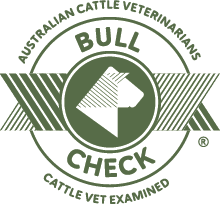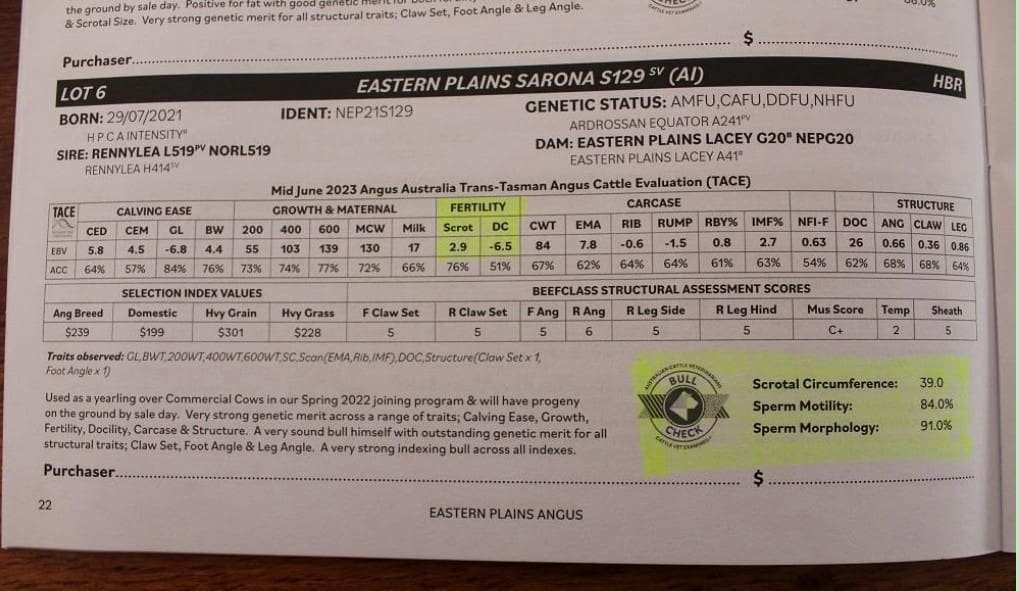Guyra (NSW) bull breeder Sally White from Eastern Plains Angus offers some thoughts on the value of bull fertility….
WITH the Spring bull selling season soon to launch, photos of fat, sappy Angus bulls with captions like ‘depth & consistency’, ‘slick coated’ and ‘easy doing’ are about to flood social and print media.
But amidst the marketing glitz and glamour, be mindful that fertility is way more important than all of the above put together when it comes to profit.
Fertility is widely recognised as one of the most important traits driving profit in beef herds. It makes economic sense to give consideration to fertility traits and have them in the mix of traits you’re selecting for when purchasing Angus bulls.
Independent objective information
While Angus is a breed noted for its fertility, variation within the breed for this important trait definitely exists. Be aware of this variation and know how to select for it.
When it comes to how bull sale catalogues describe the fertility of an Angus Bull, we urge buyers to look for independent, objective information. Quite simply, if it’s lacking it will be almost impossible to reliably and accurately select bulls for this trait.
So ….. what are we talking about when we say “independent, objective information describing the Fertility of an Angus Bull?”
Firstly, we’re talking about independent, objective information describing the fertility of that Angus bull himself, ie his own fertility (not that of his progeny). A bull’s own fertility and reproductive soundness will have a very significant impact on his fundamental job in any herd; getting females in calf earlier in the breeding season.
Be mindful the presentation of a bull on sale day, and his genotype have no relationship at all to this.
The value of BULLCHECK
 BULLCHECK is the ‘gold standard’ and most reliable means by which to objectively and accurately assess fertility in a bull. It is a standardised descriptor of bull fertility and reproductive soundness, endorsed and developed for this specific purpose by Australian Cattle Veterinarians (ACV).
BULLCHECK is the ‘gold standard’ and most reliable means by which to objectively and accurately assess fertility in a bull. It is a standardised descriptor of bull fertility and reproductive soundness, endorsed and developed for this specific purpose by Australian Cattle Veterinarians (ACV).
Even though buyers are paying a price premium when purchasing bulls out of a sale ring, without a pre-sale BULLCHECK test they’ll be assuming the lion’s share of the risk of buying an infertile or sub-fertile bull.
BULLCHECK includes:
- Physical Check – Internal sex gland palpation via rectal entry to check for irregularities which can indicate infections. Penis and sheath are examined for infections, warts or injury, and to check the penis can be extruded. Legs, feet, joints, back and gait are assessed for soundness, noting, for example, the presence of post hind legs, swollen or sickle hocks, claw set.
- Scrotal Palpation & Measurement – Scrotal circumference is measured and testicles are assessed to identify if injuries or abnormalities are present.
- Sperm Motility – Often referred to as a ‘crush side’ semen test. A drop of semen is placed on a microscope slide and examined ‘crush side’ to assess the percentage of live sperm cells moving forward. Sperm cells must be motile to achieve conception. ACV guidelines for Sperm Motility recommend a minimum of >30pc progressively motile sperm. Though we adhere to a higher standard, cataloguing only those bulls testing >50pc.
- Sperm Morphology – Cannot be tested ‘crush side’ A specialised laboratory microscope is used to examine a preserved semen sample, assessing the integrity of the sperm head, mid-piece & tail. Results detail the percentage of normal & abnormal sperm cells in a semen sample. ACV guidelines for Sperm Morphology recommend >50pc normal sperm for bulls used in multiple sire matings & >70pc normal sperm for bulls used in single sire matings or AI.
Why would a bull buyer care about Sperm Morphology?
Sperm Morphology is a heritable trait, genetically related to the interval from calving to first oestrus cycle in females. Australian research has consistently shown Sperm Morphology to be positively associated with either pregnancy rate or calf output in beef breeding bulls. Bulls which repeatedly fail minimum thresholds are at best sub-fertile, and at worst, infertile.
Though sub-fertile bulls may still sire calves, they’ll likely be costly, late-calves because their subfertility can produce a non-viable embryo so the female fails to conceive on that cycle.
Not her fault, but this forces her into the next joining cycle. It is difficult for her to then break out of this late calving cycle, increasing her chances of PTE in a subsequent joining.
If multiple-sire joining, it can be almost impossible to identify sub-fertile bulls as others in the joining team may cover for them. This exposes those fertile bulls to a greater risk of injury and thus more cost to the buyer.
The failure of a bull to test to minimum Sperm Morphology thresholds can often be transient in nature, arising from some form of stressor like nutrition, parasitism, injury, disease or husbandry.
Once recovered, the bull will likely test compliant to minimum thresholds. But until such time, his fertility status can be viewed as sub-fertile.
For all the reasons discussed above, he should not enter a bull sale ring in this state. Bear in mind too, the failure of a bull to meet minimum Sperm Morphology thresholds may not be transient, but due to some inherent, persistent or permanent fertility issue.
Repeatedly failing pre-sale testing can be evidence of this. While the diagnostic cost of determining the exact issue is often prohibitive, Sperm Morphology testing can at least identify its’ presence if not its’ exact nature.
Again, this bull does not belong in a bull sale ring in this state (most likely never).
It is important to note that BULLCHECK is not a guarantee of bull fertility. This is because bull fertility is never a constant – it varies over time in response to a multitude of stressors over which the owner may have limited control.
Nevertheless, a pre-sale BULLCHECK test is a buyer’s best option to minimise risk of buying sub-fertile or infertile bulls out of a sale ring. It substantiates that a bull has a high probability of being fertile and is fit for breeding purposes prior to him entering a sale ring.
A fair & reasonable ask, don’t you agree?

Eastern Plains bull sale catalogue carries a summary of BULLCHECK results and both fertility EBVs among the lot details for each bull.
Secondly, we’re talking about independent, objective information describing the genetic merit of an Angus bull for fertility or his ‘potential’ to pass his fertility on to his progeny.
For those buyers retaining daughters, the bulls they purchase will impact on the reproductive performance and profitability of the breeder herd for the next 10-15 years. So there is a lot at stake when it comes to the genetic merit of a bull for fertility.
Unequivocally, to reliably select for genetic merit for fertility, or the ‘potential’ of an Angus bull to pass this trait on to his progeny, we urge buyers to refer to TACE EBV’s (formerly Angus BreedPlan).
Specifically those describing fertility:
- Scrotal Size (SS):- Estimates of genetic differences between animals in scrotal circumference (cm) at 400 days of age. A larger SS EBV is more favourable. It is associated with earlier age at puberty in bull and heifer progeny (on average). As well, bulls with larger SS EBVs are expected (on average) to breed daughters with shorter days to calving – see below.
- Days to Calving (DC): Estimates of genetic differences between animals in female fertility, expressed as the number of days from the start of the joining period to calving date. A lower, more negative DC EBV is more favourable. Differences in DC are largely due to the variation in conception dates among females following the start of the joining/mating period. Some females conceive earlier, some later after bulls have been introduced to a breeding herd. Bulls with lower DC EBVs indicate they will produce daughters with shorter number of days to calving. These daughters will likely conceive earlier in the joining period so it’s probable they’ll calve earlier than their contemporaries. This gives them a better chance to return to oestrus sooner following calving, setting them up for their next joining, and to produce a calf every year. They also tend to be those which show early puberty as heifers.
Though there is a small favourable relationship between SS & DC, Australian research has shown directly selecting for DC (rather than SS alone) will help to significantly improve female fertility in a herd. Importantly, this will also help improve your profit.
